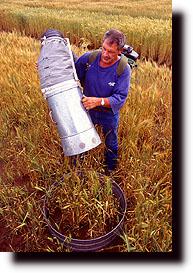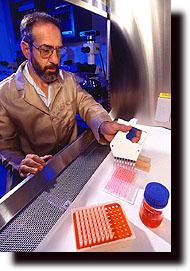 How
do scientists trap spiders in farm fields without hurting
them? In Oklahoma, ARS entomologist Matthew Greenstone,
his assistant Brian Jones, at right, and other
researchers have used giant--but gentle--vacuum cleaners.
Then the scientists figure out what little critters a
spider has been eating. How
do scientists trap spiders in farm fields without hurting
them? In Oklahoma, ARS entomologist Matthew Greenstone,
his assistant Brian Jones, at right, and other
researchers have used giant--but gentle--vacuum cleaners.
Then the scientists figure out what little critters a
spider has been eating.
One way to do this might be to dissect the spider (cut it
open), but they'd see only a gooey mess! So, Greenstone,
pictured below, and others created a special chemical
test. It can identify a prey's remains in a predator's
gut. You might call this a "gut reaction."
 In
a Georgia cotton field, scientists using the test found
that one type of spider really likes to eat the eggs of
two insects that attack the cotton plants. In
a Georgia cotton field, scientists using the test found
that one type of spider really likes to eat the eggs of
two insects that attack the cotton plants.
Recently, they surveyed wheat and other grain crops in
Colorado, looking for spiders that kill aphids, which are
major pests of these crops.
When scientists find a spider
species with an appetite for a particular pest, they can
investigate whether these spiders might eat enough pests
to help a farmer. Scientists also want to find ways that
farmers can make their fields more inviting to the
spiders.
|





